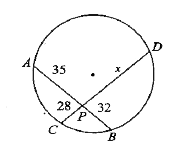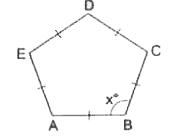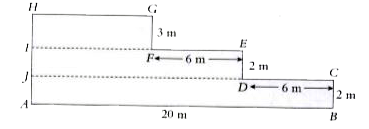By splitting the following figures into rectangles, find their areas(The measures are given in centimetres).

(a) Now, splitting the figure into I, II, III and IV rectangles as shown in the
figure below we get,
Here, area of rectangle I = length breadth
sq. cm
Area of rectangle II = length × breadth
sq. cm
Area of rectangle III = length × breadth
sq. cm
Area of rectangle IV = length × breadth
sq. cm
Now, add up the areas of all
the four rectangles to get the area of the whole
figure
= 28 sq. cm.
Therefore, the total area of figure (a) is 28 sq. cm.
(b))Similarly, splitting the
figure (b) into I, II, and III rectangles as show in
the figure below we get,
Area of rectangle I = length breadth
Area of rectangle II = length breadth
= 3 sq. cm
Area of rectangle III = length breadth
= 3 cm × 1 cm
= 3 sq. cm
Now, add up the areas of all
the three rectangles to get
the area of
the whole figure
The total area of the figure cm
= 9 sq. cm.
Therefore, the total area of figure (b) is 9 sq. cm.
Topper's Solved these Questions
- MENSURATIONBOOK - NCERTCHAPTER - MENSURATIONEXERCISE - EXERCISE 10.1
16 Videos
- MENSURATIONBOOK - NCERTCHAPTER - MENSURATIONEXERCISE - SOLVED EXAMPLES
17 Videos
- KNOWING OUR NUMBERSBOOK - NCERTCHAPTER - KNOWING OUR NUMBERSEXERCISE - SOLVED EXAMPLES
7 Videos
- PLAYING WITH NUMBERSBOOK - NCERTCHAPTER - PLAYING WITH NUMBERSEXERCISE - SOLVED EXAMPLES
13 Videos
Similar Questions
Split the following shapes into rectangles and find their areas. (The measures are given in centimetres)

View SolutionSplit the following shapes into rectangles and find the area of each (The measures are given in centimetres) Figure (ii) Figure (iii) Figure
View SolutionBy splitting the figure into rectangles, find its area

View SolutionThe following figures have been split into rectangles. Find their areas. (The measures are given in cm)
View SolutionSplit the following shape into rectangles and find the area (in sq. cm).

View SolutionFind the value of x (all measurements are in centimetres).

View SolutionFind the area of the figure given below.

View SolutionFind the angle measure x in the given figure.

View SolutionFind the area of the figure given below.

View SolutionFind the area of the trapezium given in given figure.

View Solution
